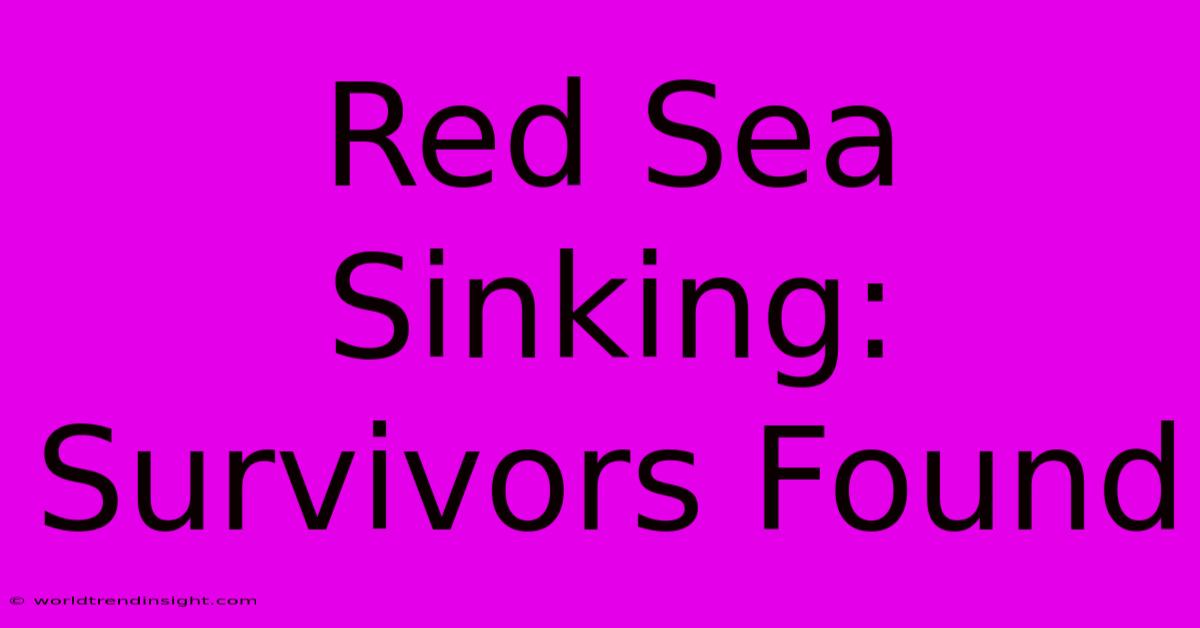Red Sea Sinking: Survivors Found

Discover more detailed and exciting information on our website. Click the link below to start your adventure: Visit Best Website Red Sea Sinking: Survivors Found. Don't miss out!
Table of Contents
Red Sea Sinking: Survivors Found - A Miraculous Rescue and Lessons Learned
Okay, folks, buckle up. This is a story about a near-death experience, a crazy rescue, and some hard-won lessons about boating safety. I'm not usually one for dramatic tales, but this one…well, it'll make your hair stand on end.
The Day the Boat Went Down
It was a beautiful day on the Red Sea. Sunshine, warm water, the whole shebang. My buddy Mark and I, we'd chartered a small sailboat – The Wanderer, we called her, ha! – for a weekend getaway. We were experienced sailors, or so we thought. We'd checked the weather forecast – looked good, right? Wrong. Big time wrong.
We were about halfway through our trip, enjoying a leisurely lunch, when things went south. Fast. Like, really fast. A sudden squall, outta nowhere, hit us with the force of a freight train. The wind howled, the waves crashed, and The Wanderer, well, she wasn't so wandering anymore – she was sinking! It all happened so fast. One minute we were laughing, the next, we were fighting for our lives.
I remember the sheer terror, you know? The cold grip of fear, the feeling of helplessness. Water everywhere. We barely managed to grab our life jackets – essential safety equipment, people! – before the boat went completely under. We were tossed around like ragdolls in a washing machine.
Near-Death Experience and Lessons Learned
The next few hours were a blur of cold, exhaustion, and the sheer will to survive. We were adrift, praying for rescue. We'd made the rookie mistake of not having a proper emergency locator beacon (EPIRB). Major fail on our part. This is something every boater should have. We thought our cell phones would suffice. They didn't. Totally useless in the middle of the ocean.
We were lucky. Incredibly lucky. A passing cargo ship spotted us after hours of bobbing in the waves. It was a miracle. We were pulled from the water, cold, scared, and exhausted, but alive.
Learn from our mistakes:
- Always carry a working EPIRB: This little device can save your life. Don't skimp on safety equipment. Seriously, it's not worth it.
- Check the weather forecast religiously: But don't just glance at it. Study it. Understand the intricacies of wind speeds, wave heights, and potential squalls.
- Have a comprehensive safety plan: Know what to do in case of an emergency. Practice your drills regularly.
- Tell someone your plans: Let someone on shore know your route, your estimated time of arrival (ETA), and your expected return time. Someone should know where you're going, when you'll be back, and who to contact if you don't return.
The Aftermath and Recovery
The rescue was only the beginning. The recovery was long and tough. I still have nightmares about that day. We were physically and emotionally drained.
But we survived. We learned some brutal lessons about the importance of safety at sea and the value of having the right equipment. If you ever plan on going sailing or boating, take this story as a harsh reminder. Don't be idiots like we were, okay?
The Red Sea can be beautiful, but she's also unforgiving. Don't underestimate her power. Respect the ocean, and she’ll respect you back.

Thank you for visiting our website wich cover about Red Sea Sinking: Survivors Found. We hope the information provided has been useful to you. Feel free to contact us if you have any questions or need further assistance. See you next time and dont miss to bookmark.
Featured Posts
-
Strong Quake Hits Ishikawa Japan
Nov 27, 2024
-
Odegaard Leads Arsenal To Ucl Victory
Nov 27, 2024
-
Pakistans Spinners Crush Zimbabwe
Nov 27, 2024
-
Ns Election Results Delayed Late Opening
Nov 27, 2024
-
2024 Chl Usa Prospects Challenge Officials
Nov 27, 2024
